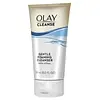What's inside
What's inside
 Key Ingredients
Key Ingredients

No key ingredients
 Benefits
Benefits

 Concerns
Concerns

 Ingredients Side-by-side
Ingredients Side-by-side

Water
Skin ConditioningCocamidopropyl Hydroxysultaine
CleansingGlycerin
HumectantSodium Lauroyl Sarcosinate
CleansingSodium Methyl Cocoyl Taurate
CleansingNiacinamide
SmoothingGluconolactone
Skin ConditioningPEG-150 Pentaerythrityl Tetrastearate
EmulsifyingCeramide NP
Skin ConditioningCeramide AP
Skin ConditioningCeramide EOP
Skin ConditioningCarbomer
Emulsion StabilisingCalcium Gluconate
HumectantSodium Chloride
MaskingSalicylic Acid
MaskingSodium Benzoate
MaskingSodium Lauroyl Lactylate
EmulsifyingCholecalciferol
Cholesterol
EmollientPhenoxyethanol
PreservativeDisodium EDTA
Sodium Hyaluronate
HumectantPhytosphingosine
Skin ConditioningXanthan Gum
EmulsifyingEthylhexylglycerin
Skin ConditioningPEG-6 Caprylic/Capric Glycerides
EmulsifyingPEG-150 Distearate
EmulsifyingCaprylic/Capric Triglyceride
MaskingTocopheryl Acetate
AntioxidantSodium Hydroxide
BufferingWater, Cocamidopropyl Hydroxysultaine, Glycerin, Sodium Lauroyl Sarcosinate, Sodium Methyl Cocoyl Taurate, Niacinamide, Gluconolactone, PEG-150 Pentaerythrityl Tetrastearate, Ceramide NP, Ceramide AP, Ceramide EOP, Carbomer, Calcium Gluconate, Sodium Chloride, Salicylic Acid, Sodium Benzoate, Sodium Lauroyl Lactylate, Cholecalciferol, Cholesterol, Phenoxyethanol, Disodium EDTA, Sodium Hyaluronate, Phytosphingosine, Xanthan Gum, Ethylhexylglycerin, PEG-6 Caprylic/Capric Glycerides, PEG-150 Distearate, Caprylic/Capric Triglyceride, Tocopheryl Acetate, Sodium Hydroxide
Water
Skin ConditioningGlycerin
HumectantSodium Myristoyl Sarcosinate
CleansingPEG-120 Methyl Glucose Dioleate
EmulsifyingSodium Lauroamphoacetate
CleansingPEG-150 Pentaerythrityl Tetrastearate
EmulsifyingSodium Trideceth Sulfate
CleansingSodium Laureth Sulfate
CleansingGlycol Distearate
EmollientPolyquaternium-10
Phenoxyethanol
PreservativeCitric Acid
BufferingCocamide Mea
EmulsifyingDisodium EDTA
DMDM Hydantoin
PreservativeAloe Barbadensis Leaf Extract
EmollientWater, Glycerin, Sodium Myristoyl Sarcosinate, PEG-120 Methyl Glucose Dioleate, Sodium Lauroamphoacetate, PEG-150 Pentaerythrityl Tetrastearate, Sodium Trideceth Sulfate, Sodium Laureth Sulfate, Glycol Distearate, Polyquaternium-10, Phenoxyethanol, Citric Acid, Cocamide Mea, Disodium EDTA, DMDM Hydantoin, Aloe Barbadensis Leaf Extract
 Reviews
Reviews

Ingredients Explained
These ingredients are found in both products.
Ingredients higher up in an ingredient list are typically present in a larger amount.
Disodium EDTA plays a role in making products more stable by aiding other preservatives.
It is a chelating agent, meaning it neutralizes metal ions that may be found in a product.
Disodium EDTA is a salt of edetic acid and is found to be safe in cosmetic ingredients.
Learn more about Disodium EDTAGlycerin is already naturally found in your skin. It helps moisturize and protect your skin.
A study from 2016 found glycerin to be more effective as a humectant than AHAs and hyaluronic acid.
As a humectant, it helps the skin stay hydrated by pulling moisture to your skin. The low molecular weight of glycerin allows it to pull moisture into the deeper layers of your skin.
Hydrated skin improves your skin barrier; Your skin barrier helps protect against irritants and bacteria.
Glycerin has also been found to have antimicrobial and antiviral properties. Due to these properties, glycerin is often used in wound and burn treatments.
In cosmetics, glycerin is usually derived from plants such as soybean or palm. However, it can also be sourced from animals, such as tallow or animal fat.
This ingredient is organic, colorless, odorless, and non-toxic.
Glycerin is the name for this ingredient in American English. British English uses Glycerol/Glycerine.
Learn more about GlycerinPEG-150 Pentaerythrityl Tetrastearate isn't fungal acne safe.
Phenoxyethanol is a preservative that has germicide, antimicrobial, and aromatic properties. Studies show that phenoxyethanol can prevent microbial growth. By itself, it has a scent that is similar to that of a rose.
It's often used in formulations along with Caprylyl Glycol to preserve the shelf life of products.
Water. It's the most common cosmetic ingredient of all. You'll usually see it at the top of ingredient lists, meaning that it makes up the largest part of the product.
So why is it so popular? Water most often acts as a solvent - this means that it helps dissolve other ingredients into the formulation.
You'll also recognize water as that liquid we all need to stay alive. If you see this, drink a glass of water. Stay hydrated!
Learn more about Water